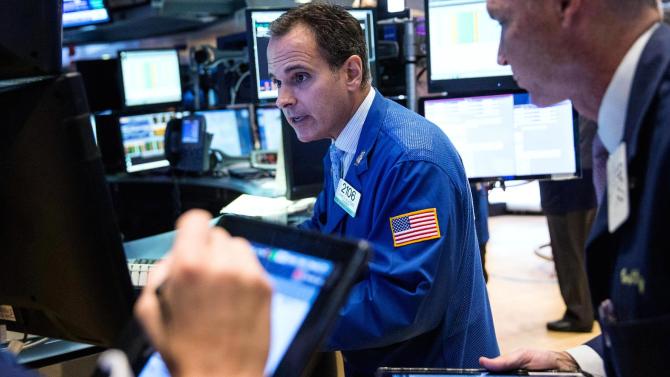Dow closes up 100, best week since March
September 11, 2015
The major averages reversed mild opening losses and wavered throughout the day before closing up about half a percent near session highs.
“The market’s in a sideways wait-and-see mode, not only because we’re going into the weekend but also the Fed meeting next week,” said Randy Frederick, managing director trading and derivatives at Charles Schwab.
The Dow Jones industrial average recouped an 85.75-point loss to surge into the close, ending up 102.69 points, boosted by UnitedHealth (UNH) and McDonald’s (MCD). The blue chip index ended up 2.05 percent on the week, its best since the week ended March 20.
The S&P 500 gained 2.07 percent for the week and Nasdaq composite gained 2.96 percent, for their best weeks since the one ended July 17.
( Tweet This )
“Technically, the end-of-day and end-of-week rally is a subtle but important sign that the bulls are getting stronger and that investors are getting more confident ahead of the Fed meeting,” said Adam Sarhan, CEO of Sarhan Capital.
“I think the market is cautious and there might be some bargain hunting going on,” said Robert Pavlik, chief market strategist at Boston Private Wealth.
“There doesn’t seem to be anything to be … behind it other than breaking that 1,947 (level on the S&P 500). We broke that 1,947 and the market moved up,” he said.
The S&P closed at 1,961, about 8 percent away from its 52-week high. The greatest declining sector, energy, closed down 0.74 percent pressured by a decline in oil prices,
Crude oil broke a 2-week winning streak to end the week down more than 3 percent.
Crude oil futures for October delivery settled down $1.29, or 2.81 percent, at $44.63 a barrel. Earlier, the commodity fell about 3 percent or more on a Goldman Sachs cut on oil price forecasts . The weekly U.S. oil rig count declined for a second-straight week, falling by 10.
Read More The trade if Goldman’s oil plunge call is right
Investors are mixed over whether the Federal Open Market Committee will raise rates at its meeting next Wednesday and Thursday.
“All eyes are on the Fed from a market perspective. Any number that could jog the Fed to tighten (is in focus),” said Ben Pace, chief investment officer at HPM Partners.
Read More Expect pre-weekend caution after head fake rally
“I think part of it is that investors believe the Fed is going to hold off,” said Quincy Krosby, market strategist at Prudential Financial. Traders “take the consumer confidence number and that’s going on the side of the conclusion the Fed keeps 2015 on the table but doesn’t act.”
Stocks hit session lows after preliminarySeptember consumer sentiment came in at 85.7 , the lowest since September 2014 and below expectations of 91.2. The final read for August was 91.9.
In a speech two weeks ago, New York Fed President William Dudley singled out the sentiment index as a potential indicator on whether or not market volatility was affecting the economy.
Fed Vice Chairman Stanley Fischer told CNBC a few days later that market volatility will affect the timing of a decision.
Read More Consumers may have just blocked a Sept rate hike
“U.S. economic data in a vacuum supports a rate increase story now,” said James Meyer, chief investment officer at Tower Bridge Advisors. “Volatility, emerging markets and lack of inflation say, what’s the rush?”
Since the correction at the end of August, the major averages have swung wildly and only recently turned calmer. The Dow Jones industrial average had its first sub-triple-digit close Thursday since Sept. 3.
The S&P 500 has alternated between weekly gains and losses for the last 10 weeks, according Standard & Poor’s.
“We’re in a really weak market environment technically here,” Pace said. “We were at an abnormally low level of volatility for an abnormally long period of time.”
The VIX near 24 is “much more normal, not extreme,” he said.
The CBOE Volatility Index (VIX) (^VIX), widely considered the best gauge of fear in the market, ended the week near 23.
“The market is getting a little bit stronger. I think just coming off a scare (after) China’s equity market had a dramatic drop,” said Tom Digenan, head of U.S. equities at UBS Global Asset Management. “After the initial shock I think you look at the company level and you see opportunities because there was indiscriminate selling.”
“Don’t fear the Fed. Focus on the companies,” he said, noting that investors should focus on the Fed’s likely accomodative stance in the long term.
Treasury yields held slightly lower, with the 10-year yield (U.S.:US10Y) at 2.19 percent and the 2-year yield (U.S.:US2Y) at 0.71 percent.
The U.S. dollar traded mildly higher, with the euro creeping up above $1.13 and the yen little changed near 120.6 yen against the dollar.
Gold briefly fell below $1,100 an ounce, before settling at $1,103.30, down $6.00. The precious metal fell 1.6 percent for the weekk.
Before the open, futures extended losses slightly after the Producer Price Index (PPI) for August came in unchanged , mildly beating expectations for a 0.1 percent decline. The core PPI was up 0.7 percent in the 12 months through August.
“The key thing they focus on is inflation. (It’s) still notably low,” said Tara Sinclair, chief economist at Indeed. The argument that a slight beat on expectations supports a rate hike “gives too much weight on one month.”
Sinclair said with low inflation and possible slack in the labor market the Fed should not move next week, but could hike rates later this year if the data continues to strengthen.
In other economic news, the United States posted at $64 billion deficit in August for a total deficit of $424 billion so far this year. The annual deficit has fallen 18 percent from August 2014.
In Europe, the pan-European STOXX 600 index closed down about 1 percent , with investors also looking to next week’s Fed decision. In Asia, the Shanghai Composite Index (Shanghai Stock Exchange: .SSEC) closed 0.08 percent higher, while the Nikkei (Nihon Kenzai Shinbun: .N225)was down 0.19 percent.
On the earnings front, Mattress Firm (MFRM) missed estimates by 5 cents with adjusted quarterly profit of 67 cents per share, with revenue also missing forecasts.
Kroger (KR) reported second-quarter earnings of 44 cents a share on revenue of $25.54 billion, for a 25 percent increase in profit from the same period last year. The stock closed up 5.3 percent.
Read More Early movers: CVX, IPG, CRM, MDLZ, EBAY, HAL & more
Stocks closed higher Thursday, off session highs as a bounce in oil and Apple failed to completely offset increased uncertainty over the Fed.
Apple (AAPL) ended the day up about 1.3 percent, with gains of 4.3 percent for the week.
The Dow Jones industrial average (Dow Jones Global Indexes: .DJI) closed up 102.69 points, or 0.63 percent ,at 16,433.09, with McDonald’s (MCD) leading advancers and Cisco (CSCO) the greatest laggard. UnitedHealth jumped 5.6 percent for the week as the greatest gainer for the week, while Chevron (CVX) ended down nearly 1.2 percent as the greatest decliner.
The Dow transports closed up 0.26 percent for a weekly gain of 3.3 percent, its best week since the one ended July 31.
The S&P 500 (^GSPC) closed up 8.76 points, or 0.45 percent, at 1,961.05, with utilities leading eight sectors higher and energy and materials the only decliners. Information technology was the greatest weekly gainer with a 3.1 percent rise. Energy was the only sector lower on the week. off 0.7 percent.
The Nasdaq (^IXIC) closed up 26.09 points, or 0.54 percent, at 4,822.34.
The iShares Nasdaq Biotechnology ETF (IBB) (IBB) gained 1.15 percent Friday. The index ended the week 5.23 percent higher, its best since the one ended July 17.
About eight stocks advanced for every seven decliners on the New York Stock Exchange, with an exchange volume of 833 million and a composite volume of 3.2 billion in the close.
High-frequency trading accounted for 49 percent of this month’s daily trading volume of about 7.3 billion shares, according to TABB Group. During the peak levels of high-frequency trading in 2009, about 61 percent of 9.8 billion of average daily shares traded were executed by high-frequency traders.
More From CNBC.com:
Search
RECENT PRESS RELEASES
Related Post






